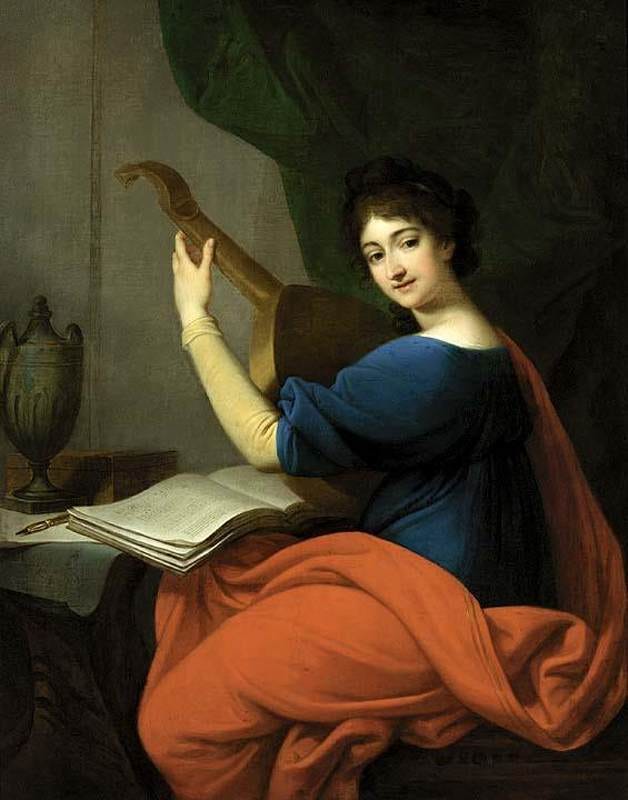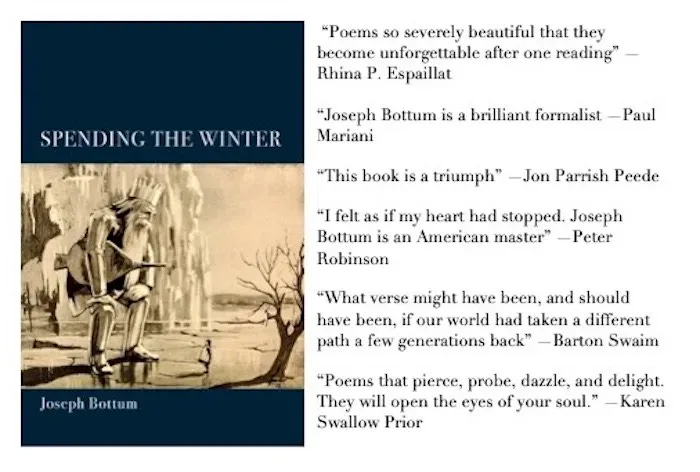
When to Her Lute Corinna Sings
by Thomas Campion
When to her lute Corinna sings, Her voice revives the leaden strings, And doth in highest notes appear As any challenged echo clear; But when she doth of mourning speak, Ev’n with her sighs the strings do break. And as her lute doth live or die, Let by her passion, so must I: For when of pleasure she doth sing, My thoughts enjoy a sudden spring, But if she doth of sorrow speak, Ev’n from my heart the strings do break. ═══════════════════════
Already, at fairly wide intervals, we’ve taken two looks at Shakespeare’s contemporary Thomas Campion (1567–1620), poet, theorist, and composer of lute songs and madrigals. Although we talk daily about musical elements in poetry, and although we’ve discussed poems that have been rendered in musical settings — George Herbert’s “Love (III),” for example, set by Ralph Vaughan Williams, in the early 20th century, as one of his Five Mystical Songs — it’s relatively rarely that we’ve considered poems written explicitly to be sung.
Today’s Poem, “When to Her Lute Corinna Sings,” is one such poem. Written around 1601, the year before the publication of Campion’s Observations in the Art of English Poesy, in an era when girls named Corinna were all the rage, the poem on the page occurs in two stanzas of clear, unstrained iambic tetrameter. It’s precisely the sort of verse Campion would advocate for in his treatise on prosody, in which he exhorts poets writing in English to take care in ensuring that their use of classical metrical feet doesn’t force contorted pronunciations of vernacular words by casting stresses onto syllables that would never be stressed in normal speech.
Limpid as its meter, the poem’s argument is a neat, unforced little syllogism in which Corinna’s oneness with her lute becomes her lover’s oneness with the lute, which ultimately means his oneness with Corinna herself. This pattern of identification, in which the lute (like John Donne’s earthier conceit of the flea) signifies the mutuality of feeling between the lovers, finds its echo in the patterning of the meter — an echo amplified as you read the poem aloud, and especially as you try the various ways that you might plausibly read it.
When you read the poem aloud, trying to sound natural, you might not read every line as four unambiguous iambs, four unstressed-stressed syllable pairs. You’re less likely to read the first line as, “When TO her LUTE CorRINna SINGS,” than to emphasize the line’s first syllable: “WHEN to her LUTE CorRINna SINGS.” This is also more or less how the line, in Campion’s notation, is set to be sung.
Listening, you can hear the freer play of stresses, the singer leaning on some words, hastening through other phrases, the music supporting a certain dramatic arc in the words. In that arc, temporality in the poem’s first line — “when” — finds its parallel at the start of the second stanza in the stressed “and” of simultaneity.
You, the listener or reader, are drawn into a bubble of time in which multiple things are happening. Corinna is playing her lute. She sings happy or sad songs, and the strings either ring with a voice like hers, or they break, as a heart breaks. Her lover, listening, is like the lute and feels both its sensations and hers in himself. These are all separate occurrences, yet in this bubble of time, the “when/and” moment, they are all the same layered experience. Even the contradictions signaled by “but” are simply movements of that one experience, which itself is oneness.
But let’s say that you decide for the moment to forget about the music, and instead, as an alternative experiment, to read the poem as it appears on the page, in four pairs of unstressed-stressed syllables, as metronomically as you can. This might not be the most expressive reading, but it may be illuminating. Notably, you can read the poem in this way without any particular linguistic contortions. No word gets mangled by the meter out of its natural shape. But in this approach to reading the poem, new patterns emerge, and it’s interesting to note them.

What emphases emerge in this reading? To a great extent, the emphasis falls on words you’d consider important anyway, such as “lute,” or “live,” or “die.” The musical setting also stresses those words. Those are perfectly natural words to stress. But in the first foot of the first line, reading the iambs strictly, you’d also find yourself emphasizing the preposition “to,” in a way that we don’t in ordinary speech — unless we want, again, for some reason, to emphasize the preposition, that relation-defining part of speech, in order to highlight the relation the preposition defines.
In the poem’s first line, then, what becomes apparent through that scansion is that Corinna isn’t simply singing, accompanied by a lute. She sings to the lute, in both senses of that phrase, so that it becomes both her accompaniment and her audience of one, sung to as she would sing to a lover. That detail, to which a strict observation of the meter calls attention, introduces an intimacy between Corinna and the lute that the rest of the poem bears out.
The last line of that first stanza casts emphasis, again, on a preposition, in precisely the same way: “Ev’n with her sighs the strings do break.” The lute isn’t merely a passive listener; it has been awakened and enlivened, tuned to share her emotions. Maybe you knew this anyway, but a strictly metrical reading highlights that connection.
In the second stanza, where the musical setting emphasized the “and,” to suggest something about simultaneous experience in time, a strict metrical reading foregrounds the conjunction “as,” the second syllable of that line, to illuminate the analogical connection between the lute and the listening lover. Now, like the lute, this lover, the poem’s “I,” has been attuned to Corinna’s interior life, to experience her emotions with her.
That circle of relations — Corinna to lute, lute to lover, lover to Corinna — extends itself through the iambic stressing of the preposition, “by,” in the first foot of line 8, for instance, illuminating the union of her “passion” with his. Throughout the poem, those seemingly throwaway prepositions are foregrounded, when we read the meter strictly, as the words of relationship on which everything turns. All of this is done with a delicate, self-effacing touch, as light as the simple treble vocal line and stringed accompaniment of the solo “ayre.”
It’s worth it, in other words, to read a poem aloud more than once — and it’s worth it to mark and observe the meter as written, even if the strictest interpretation of the meter is not ultimately how you’d perform the poem. The interplay between the exact pattern of the meter and the way the words themselves urge the reader to hear them, and then again between that exact pattern and the even more fluid movement of the poem as a song, all must be managed by the poet-composer in such a way that every element works with every other, without any distortion of either sound or sense. To experience this poem in these various ways, and to see how it holds up in sound and meaning, is to recognize Campion as a master.






I already loved this poem, but your post gave it a whole new amazing meaning by paying close attention to all those important prepositions I was carelessly disregarding! Thanks! You help me read more carefully!
Marvellous piece! Thank you! You can the mirror effect when a poem that wasn’t written to be sung is transformed when a great musician sets it to music, and it captures the poem so well that it’ll always be sung in your imagination. I’m thinking of Benjamin Britten here and particularly his settings of Thomas Hardy, and the poems in his Serenade for Tenor, Horn & Strings.